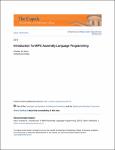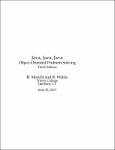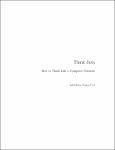Browsing by Subject Java
Showing results [1 - 7] / 7
"This book was written to introduce students to assembly language programming in MIPS. As with all assemblylanguage programming texts, it covers basic operators and instructions, subprogram calling, loading andstoring memory, program control, and the conversion of the assembly language program into machine code.
However this book was not written simply as a book on assembly language programming. The larger purposeof this text is to show how concepts in Higher Level Languages (HLL), such as Java or C/C++, arerepresented in assembly. By showing how program constructs from these HLL map into assembly, theconcepts will be easier to understand and use when the programmer implements prog... |
"Welcome to the Eighth Edition of Introduction to Programming Using Java, a free, on-line textbook on introductory programming, which uses Java as the language of instruction. This book is directed mainly towards beginning programmers, although it might also be useful for experienced programmers who want to learn something about Java. It is not meant to provide complete coverage of the Java language.
The eighth edition requires Java 8 or later, and it uses JavaFX for GUI programming. Version 8.1 is a small update of Version 8.0. This version briefly covers some of the new features in Java 11 and makes it clearer how to use this book with Java 11 and later." |
This book is Part I of a two-part set that introduces the Java programming language. The text assumes the student will be using the BlueJ development environment and provides some introductory BlueJ material. Our experience has been that BlueJ is easy to learn and provides a good programming environment for the beginner programmer. |
This book is Part II of a two-part set that introduces the Java programming language. The text assumes the student will be using the BlueJ development environment and provides some introductory BlueJ material. Our experience has been that BlueJ is easy to learn and provides a good programming environment for the beginner programmer. |
"We have designed this third edition of Java, Java, Java to be suitable for a typical Introduction to Computer Science (CS1) course or for a slightly more advanced Java as a Second Language course. This edition retains the “objects first” approach to programming and problem solving that was characteristic of the first two editions. Throughout the text we emphasize careful coverage of Java language features, introductory programming concepts, and object-oriented design principles.
The third edition retains many of the features of the first two editions, including:
Early Introduction of Objects
Emphasis on Object Oriented Design (OOD)
Unified Modeling Language (UML) Diagrams
Se... |
"I never seemed to find the perfect data-oriented Python book for my course, so I set out to write just such a book. Luckily at a faculty meeting three weeks before I was about to start my new book from scratch over the holiday break, Dr. Atul Prakash showed me the Think Python book which he had used to teach his Python course that semester. It is a well-written Computer Science text with a focus on short, direct explanations and ease of learning.The overall book structure has been changed to get to doing data analysis problems as quickly as possible and have a series of running examples and exercises about data analysis from the very beginning.
Chapters 2–10 are similar to the Thi... |
"Think Java is a hands-on introduction to computer science and programming used by many universities and high schools around the world. Its conciseness, emphasis on vocabulary, and informal tone make it particularly appealing for readers with little or no experience. The book starts with the most basic programming concepts and gradually works its way to advanced object-oriented techniques.
In this fully updated and expanded edition, authors Allen Downey and Chris Mayfield introduce programming as a means for solving interesting problems. Each chapter presents material for one week of a college course and includes exercises to help you practice what you’ve learned. Along the way, yo... |







